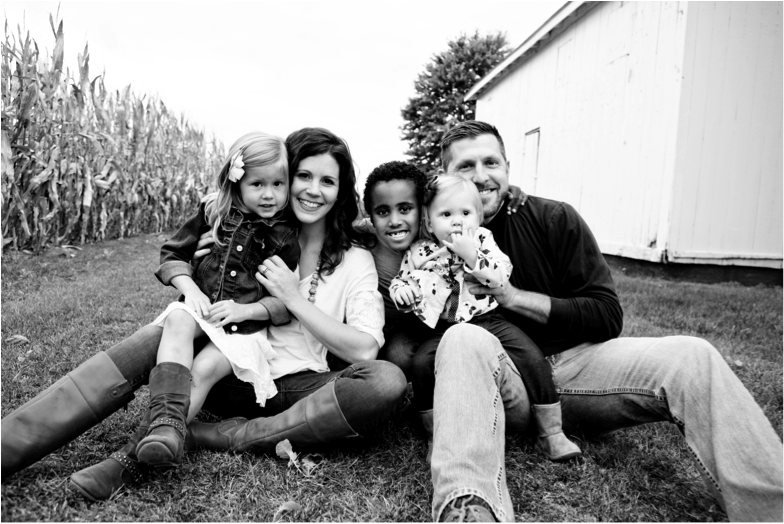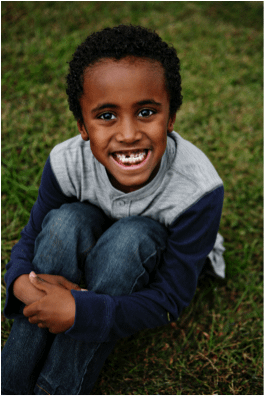I’m SO excited to kick of my series on Adoption for National Adoption Awareness Month! Every week, I will have a different family guest post on their adoption journey. I have specifically chosen several families who have each done a different type of adoption (international, domestic and from foster care). I’m really excited to hear from these families, and I hope you are, too! And just in case you aren’t following along on Instagram or Facebook, I’m also participating in the #knittogetherbyadoption posts each day.
Today my focus is on International Adoption. I reach out to Rachael (who has also guest posted here) and asked her some questions about their international adoption(s) from Ethiopia.
____________________________________________________
Hello all! We are Jon and Rachael Oren and adopted our first son, Mekonen, from Ethiopia when he was 8 months old. He will be turning 7 this December! Following Mekonen, we have two biological daughters, Evie- age 4, and Penelope- age 1. We are currently in process waiting to bring our second son home from Ethiopia! He is two years old!
“Why Not Adopt a Kid from the U.S.?”
This has been a question that we have been asked multiple times over the last 7 years ever since we began the adoption process for our first son- So why adopt from another country? Why not adopt from here? And the second time around, when we announced we are adopting from Africa again, we got the question several more times. For our second adoption, the choice of where to adopt from holds an entirely new set of things to take into consideration given our current family make-up.
We have asked ourselves this question too. Why not adopt from here?
This blog post will only barely touch the surface of all that could be said on the subject. I’m being completely serious when I say that I have read thousands of real, legitimate adoption research and trust me when I say, adoptive families do not take their choices in the adoption process lightly, and that includes which process to go with- domestic or international.
- Kids are kids. When it comes down to it, kids are kids, whether here in the U.S. or in another country. At some point it can’t be a country versus country thing, and instead there needs to simply be a recognition that kids belong in families- that includes “U.S.” kids, and kids from other countries. Personally, God has given Jon and I a heart for the global orphan crisis, not just the local orphan crisis. And, when it comes down to it, it’s kids needing a mom and a dad. That’s it. Kids in families. That’s what matters!
- Different process. Different circumstances. The adoption process for domestic adoption and the process for international adoption varies drastically. If someone is not well versed in the adoption world, they might not realize this. There are so many things families have to work through and consider when choosing which adoption avenue to pursue, especially a second time around when there are already children in the home, and even more so when any of those current children are also adopted. Things like birth order, gender order, family dynamics, personalities, age of the child when adopted, life situation of the family, adoption history, etc. that families must discuss and must decide on. Some of the above circumstances don’t fit well with domestic adoption and some of the above circumstances don’t fit well with international adoption. I could provide illustration after illustration, but it would take far too long for this post!
- Current Family Dynamics.This goes along with number 2 above. Many, no not all, but many domestic adoptions have some form of openness to them; and many, no not all, international adoptions have more of a closed way about them. This needs to be taken into consideration if there is already an adopted child in the home. If you had two children in your home, both of which were adopted, and both had drastically different adoptive upbringings regarding their birth families, this could cause issues. For every family? No. For every child? No. But we know our children, and we do know the kinds of situations they would handle well.
- Desire. Among many things in adoption, desire is huge. The motivation to adopt should never be to “save” or “rescue” a child. A child deserves, needs, and longs to be WANTED. To be desired. To be pursued with everything you have. They are to be desired simply because they are who they are. With that, also comes desire, or interest in, where your child comes from. God has given some people the burning desire to care for kids needing families here in our backyard in the United States, and God has given some people the burning desire to care for kids needing families that reside in other countries. There is nothing wrong with either of these. Again, kids are kids. And ALL kids deserve a family. For us, we both grew up with a global mindset, with families and churches who had their eyes on the world outside their backyard. For as long as I can remember, my heart has been drawn to people and circumstances outside the U.S. Although there are many similarities, the circumstances that bring international children to adoption and the circumstances that bring U.S. children to adoption are very different. Our hearts are burdened for the very specific circumstances in the developing world that bring children to a place of needing adoption.
- Need. Although the similarity of kids needing families exists in domestic adoption and international adoption, there is also the very real truth that not all children in other countries even get a shot at a family, unless it’s through international adoption. This is due to the very hard truth that many of these children are coming from places where domestic adoption does not even exist, or it exists in such small numbers that it’s not even really practiced, or there are places where the orphan is the most looked down upon member of society and socially they are outcasted, even among their own culture. Is that something that needs to change internationally? Absolutely!!! And we are right now, connecting ourselves to people and organizations who are attempting this very thing, including sponsoring a child in Kenya who IS able to stay in her birth country, because long-term, those are the kinds of issues we want to be part of and want to help change. But changing the way society and countries views orphans and adoption is a very slow and painful process. And in the meantime, there are children growing up undercared for, unprotected, and unloved. We simply cannot ignore them until “someone changes their country’s views on domestic adoption and orphans.” Trust me. I’ve read the research. I’ve read the stories of the agencies and organizations trying to do this very thing, and it is incredibly difficult. And on top of that, is the fact that most of the developing world does not have vast numbers of people financially able to care for more children.
Personally, we have knocked on more doors in the adoption world than people realize, and not just international doors. When we first started to pursue our second adoption, we did in fact, look into local foster to adopt. However, at the time, there were no children in our direct area that fit our family’s criteria for birth order, ability to care for specific needs, etc. The spacing of children, the gender ratio, and the need for some children needing adoption to be the only child in a family, or the youngest in a family, are all things that affect adoption choice.
We see our home like a revolving door for various avenues of orphan care when the time is right – US adoption, foster care, Safe Families, international adoption, non-US domestic adoption advocacy, non-adoption oriented child development, etc, etc. The issues are many and vast – here or there.
We are currently adopting from Ethiopia again for reasons specific to our family situation now and long-term. With the research out on racial identity, we cannot ignore the value in giving our first adopted child another sibling who shares his same culture and heritage. It’s a priceless gift not everyone has and one we are so incredibly thankful for. Here are our two Ethiopian boys. We cannot share the name or show the full face of our new son until our process is complete. But he sure is a handsome little guy!
Phew! So now you that you read all my blabbering about international adoption, maybe you’re wondering what the run-down is of the process. Every single country is different, but there are general similarities in what steps are taken to complete an international adoption.
- Choose an adoption agency that is ethical and trustworthy. Do your research!
- Decide on a country- lots of things go into this such as desire and love for the country, and whether or not you meet that country’s requirements for adoptive parents
- Compile your homestudy- a long and lengthy process of U.S. paperwork that approves you to be an adoptive parent
- Compile your dossier- another long and lengthy paperwork process that is specific to the country you are adopting from
- Wait to be matched with a child by your agency, or be matched with an already waiting child that your agency is advocating for
- Court process- this process can vary drastically from country to country. Some countries also require you to attend the in-country court date, others do not.
- Once you pass court, the country process differs greatly from country to country. For us, once we are court approved, we will travel to Ethiopia to attend another court hearing and bring our son home!
- Even though your child is legally adopted and legally yours, as well as an American citizen once the plane hits U.S. soil, you still need to go through the re-adoption process for your state. This enables your child to get a U.S. social security card as well as a U.S. passport.
The tension among the often talked about debate over international adoption versus domestic adoption will always be there. But, what we must come back to again and again is that KIDS, and KIDS IN FAMILIES, is what matters, whether here, or there. God dwells with and weeps over the child here and the child in China without a home. What we must always come back to is simply doing something.
_________________________________________________________
Thank you so much, Rachael for sharing. I so appreciated this post and the grace with which the subject was approached!
Rachael also blogs about adoption, their crazy awesome hobby farm life, and homeschooling over at Our One Piece Life.



